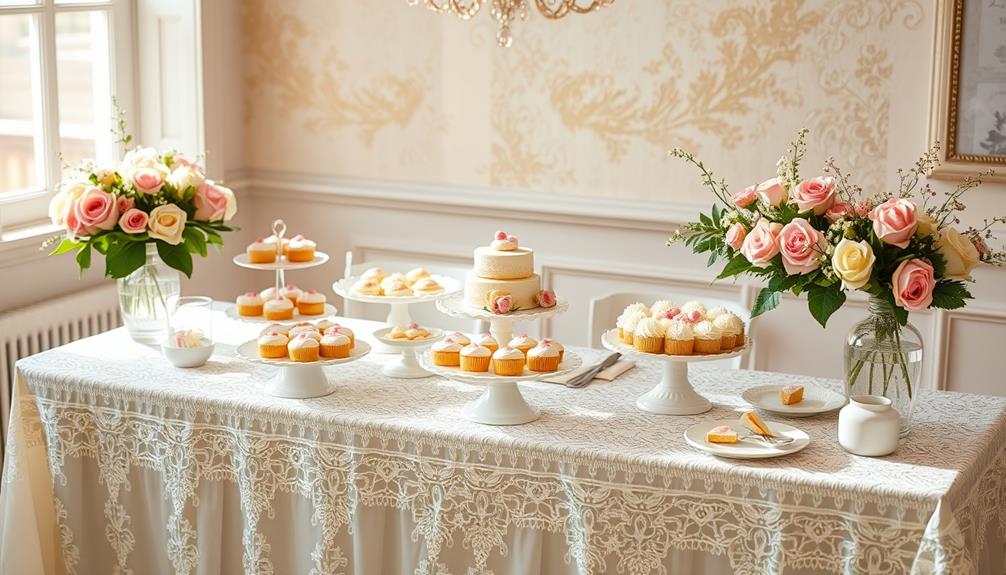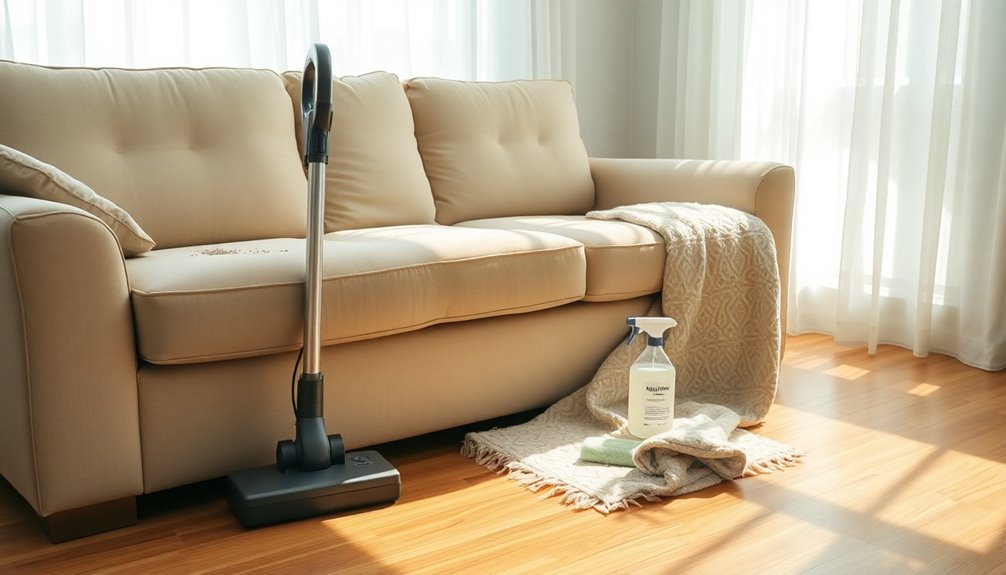You can easily elevate your dessert table and make it a captivating focal point by focusing on colors, heights, and themed treats. Begin by using a lovely tablecloth, such as a light turquoise satin, to establish the ambiance. Add dimension with tiered stands and decorative accents, showcasing vibrant desserts at the forefront for a striking effect. Aim for a selection of 5 to 7 treats that complement your chosen theme, ensuring a cohesive appearance. Keep your color scheme limited to 2-3 primary shades for a visually pleasing display. Stay tuned for more advice on enhancing your dessert presentation! To enhance the tropical vibe, consider including fresh fruits or tropical-inspired desserts like pineapple upside-down cake or coconut macaroons. Integrate greenery, such as small palm leaves or tropical flowers, to further enhance the theme and achieve a tropical interior aesthetic that will impress your guests. By paying attention to these details, you can create a visually stunning dessert table that will steal the show at your event.
Key Takeaways
- Choose a light turquoise satin tablecloth for a polished and professional look that complements your theme.
- Create height variation using tiered stands and decorative risers to enhance visual interest and dimension.
- Strategically position colorful desserts at the front, ensuring a diverse selection of 5 to 7 treats for maximum appeal.
- Limit your color palette to 2-3 main colors for visual harmony and cohesive presentation throughout the dessert table.
- Incorporate DIY decor hacks, such as overturned plates for height and repurposed items for a stylish yet budget-friendly setup.
Tablecloth Selection and Coordination

When you're planning a dessert table, selecting the right tablecloth is essential because it sets the tone for the entire display.
Choose a light turquoise satin cloth for a professional and invigorating look. Make sure it fits your rectangular table neatly; high-quality tablecloths from reliable suppliers elevate the overall presentation.
Think about your theme—rustic, vintage, modern, or seasonal—as it guides your decor decisions. Limit your color palette to 2-3 main colors for visual harmony.
Incorporate these theme colors into your desserts for a unified presentation, which enhances guest engagement. By aligning your dessert offerings with the overall aesthetic of your retreat center, you not only create a visually appealing experience but also foster a deeper connection among guests. Thoughtfully designed desserts can transform your retreat center design, making each element work harmoniously together while leaving a lasting impression on everyone who visits. The synergy between colors and flavors can elevate the culinary experience, turning meals into memorable moments that guests will cherish.
Creating Height Variation

Creating a visually engaging dessert table hinges on height variation. To achieve this, position taller items at the back, allowing guests to see everything clearly.
Incorporate decorative elements like cake stands and risers to elevate desserts and create interest. Tiered stands work wonders, adding layers that draw the eye across your setup.
Stack plates or trays on sturdy supports to maximize space efficiently. Fill any empty areas with vases or decorative frames, ensuring a cohesive look.
Essentials for Dessert Arrangement

After establishing height variation to draw the eye, it's time to focus on the arrangement of desserts to maximize their visual appeal.
Start by choosing a theme that complements your event, ensuring all elements reflect that theme for a cohesive look. Position colorful desserts strategically, placing the most eye-catching items at the front and center.
Vary the heights of your dessert items using decorative serving ware like cake stands and platters. Aim for a mix of 5 to 7 diverse treats, including 1 or 2 designer sweets, and sprinkle in a few candy types for added variety.
Budget-Friendly Decor Hacks

Even if you're on a tight budget, you can still create an impressive dessert table that wows your guests. Start by using overturned plates glued to sturdy glasses for DIY height variation—this adds dimension without breaking the bank.
Repurpose decorative items like vases, frames, or jars to fill empty spaces cost-effectively. For a backdrop, consider affordable materials like fabric or shower curtains, which can transform your setup instantly.
Upside-down bowls or boxes can elevate treats without extra spending. Get creative with everyday items—trays or glassware can serve stylish purposes.
Color Palette Considerations

Choosing the right color palette is essential for a stunning dessert table that captures your guests' attention. A well-thought-out color scheme sets the mood and enhances your overall theme.
To achieve a cohesive look, consider these tips:
- Limit Your Colors: Stick to 2-3 main colors to avoid overwhelming the table and maintain visual harmony.
- Enhance with Accents: Use accent colors to highlight certain desserts or decorations, creating focal points that draw the eye.
- Coordinate with Decor: Verify your color palette aligns with other elements, like tablecloths or dishes, for a unified presentation.
Themed Dessert Choices

A dessert table can truly shine when its treats reflect the chosen theme. Think about the vibe you want to create—whether it's rustic, vintage, or modern. Choose desserts that complement that atmosphere.
For a beach-themed party, consider coconut cupcakes, sea salt caramel tarts, or ocean-blue jello cups. If you're hosting a vintage tea party, scones, macarons, and elegant layered cakes fit perfectly.
Don't forget to incorporate your theme colors into the desserts; it ties everything together beautifully. Aim for variety, including 5 to 7 different treats, with a couple of designer sweets or unique candies.
This thoughtful selection not only enhances the overall experience but also makes your dessert table a conversation starter for guests.
Enhancing Visual Appeal

To truly make your dessert table stand out, enhancing its visual appeal is key. You can achieve this by focusing on a few essential elements: First, consider the color scheme of your dessert table. Using a cohesive color palette can create a visually stunning display. Additionally, incorporating elements of Indonesian interior design, such as intricate patterns, bright colors, and natural materials, can add a unique and exotic touch to your dessert table. Lastly, don’t forget to pay attention to the presentation of your desserts – using different heights, textures, and decorative accents can make your table look even more appealing.
- Tablecloth Selection: Choose a tablecloth that complements your theme. A light turquoise satin can create a professional and invigorating look.
- Height Variation: Use tiered stands and decorative items to create dynamic height differences. Position taller items at the back to guide guests' eyes across the table.
- Strategic Arrangement: Place colorful desserts prominently and vary heights to add dimension. Aim for a mix of 5 to 7 treats, including designer sweets, for an engaging display.
Frequently Asked Questions
How Can I Personalize My Dessert Table for a Special Occasion?
To personalize your dessert table, choose a theme that reflects the occasion, incorporate the guest of honor's favorite colors, and include custom desserts or labels. Add meaningful decorations to enhance the personal touch and create lasting memories.
What Are Some Tips for Choosing Dessert Flavors That Complement the Theme?
Think of your dessert table as a beautifully painted canvas. Choose flavors that echo your theme—if it's rustic, opt for warm spices; if modern, go for bold, unexpected combinations. Let your creativity shine through delicious pairings!
How Do I Ensure My Dessert Table Is Kid-Friendly?
To guarantee your dessert table's kid-friendly, choose colorful, fun treats like cupcakes and cookies. Incorporate playful decorations, keep servings bite-sized, and include labels for allergen awareness. Make it interactive with DIY decorating stations for added excitement!
What Lighting Options Enhance the Dessert Table's Visual Appeal?
How can you elevate your dessert table's charm? Use soft, warm lighting like fairy lights or candles to create a cozy atmosphere. It not only enhances visual appeal but invites guests to indulge in sweet treats.
How Do I Manage Dessert Table Space in a Small Venue?
To manage dessert table space in a small venue, utilize tiered stands for height variation, arrange desserts strategically for accessibility, and fill gaps with decorative items to create an inviting, cohesive display without overcrowding.
Conclusion
With these tips, your dessert table will shine like a beacon of sweetness at your event. By thoughtfully selecting your tablecloth, incorporating height, and choosing the right colors and themes, you can create a stunning display that captivates your guests. Don't forget those budget-friendly hacks to keep it stylish without breaking the bank. Now, go ahead and release your creativity—your dessert table is sure to be the highlight of the celebration!









